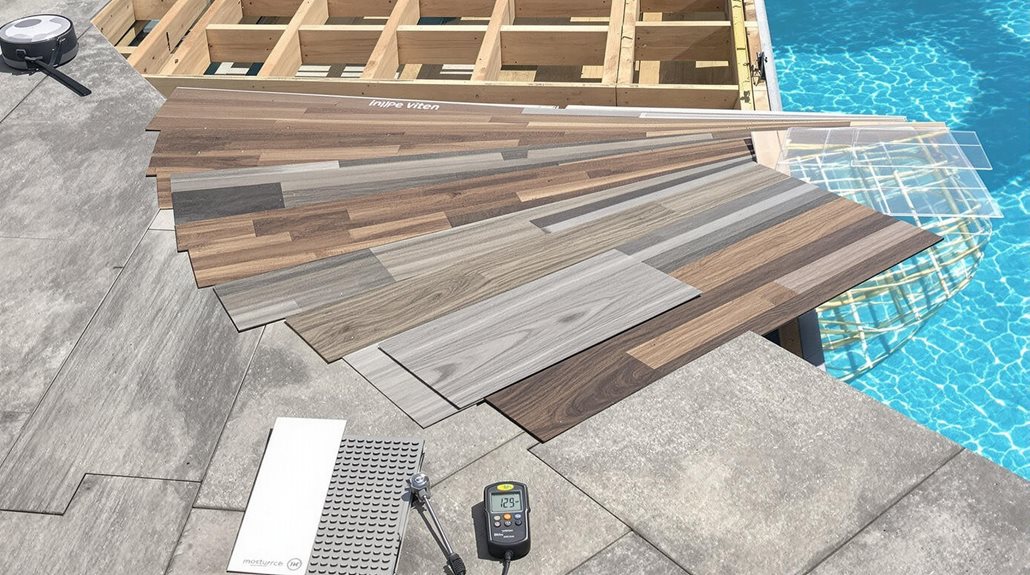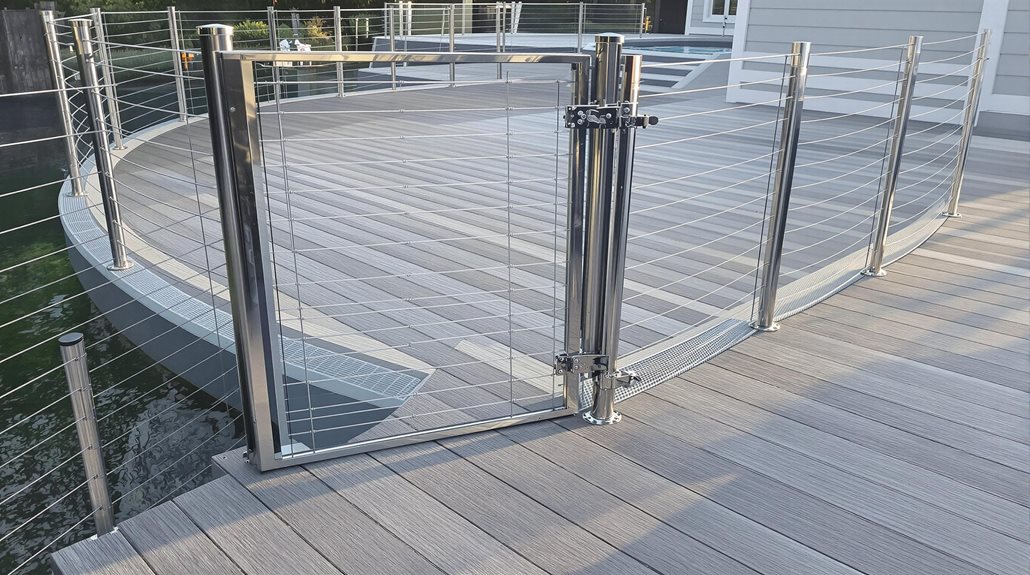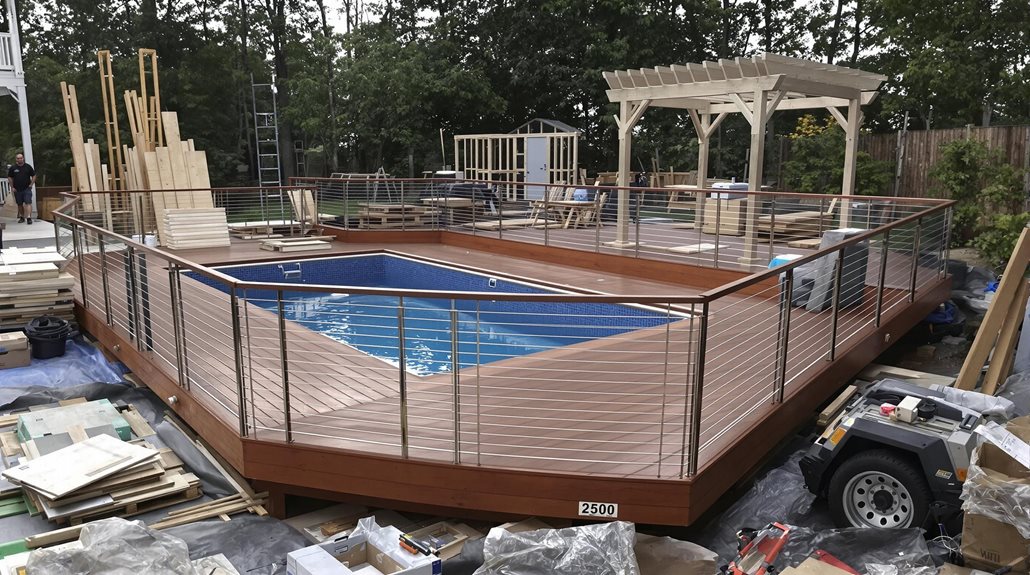Poolside Deck Construction: Materials, Designs, and Safety Considerations
Constructing a poolside deck involves careful selection of materials to avoid risks like rot and warping associated with untreated wood. Durable options such as composite decking, teak, and ipe offer resistance to moisture and UV damage. Design should complement the pool and landscape, incorporating features like multi-level decks, built-in seating, and lighting for extended usability. Safety is vital, with slip-resistant materials, sturdy railings, and regular electrical checks being essential. Proper installation and maintenance, including regular inspections and periodic cleaning, guarantee longevity. By planning carefully and budgeting for the right materials and features, you can create a safe and enjoyable outdoor space that will last for years to come. For more detailed guidance on these considerations, continue exploring the key aspects of poolside deck construction.
Expert Highlights
- Choose durable materials like composite decking, teak, or ipe to ensure safety and longevity, avoiding untreated wood's risks of rot and warping.
- Design the deck to complement the pool and landscape, considering multi-level designs, built-in seating, planters, and lighting for enhanced usability.
- Ensure slip resistance with textured decking materials or non-slip coatings and install sturdy railings that meet height and spacing regulations.
- Prioritize electrical safety by hiring licensed electricians for installations and perform regular inspections to identify and repair potential hazards.
- Plan carefully, including budgeting for materials, labor, and additional features like railings and lighting, to ensure a safe and functional poolside deck.
Choosing the Right Materials for Your Poolside Deck

When constructing a poolside deck, choosing the right materials is essential to guarantee both safety and longevity. The pool environment poses unique challenges, such as constant moisture and exposure to chemicals, which can degrade certain materials quickly.
For instance, wood decks made from untreated lumber can rot or warp over time, leading to structural issues and safety hazards.
To mitigate these risks, consider using durable and resistant materials like composite decking or hardwoods such as teak or ipe.
Composite decking combines wood fibers with plastic polymers, offering excellent resistance to moisture and UV damage.
Hardwoods are naturally dense and less prone to warping or rotting. These materials not only assure a longer lifespan for your deck but also reduce maintenance needs, providing a safe and enjoyable space around your pool.
Slip-resistant pool deck surfaces are crucial for preventing accidents and ensuring safety around the water area.
Design Options for Poolside Decks
After selecting the appropriate materials for your poolside deck, the next step involves exploring the various design options available. One of the primary challenges is ensuring that the deck complements both the pool and the surrounding landscape.
To address this, consider a multi-level deck design, which can create a seamless connection between different areas of your outdoor space. Another option is to incorporate built-in seating and planters, enhancing the aesthetic appeal and functionality of the deck.
Additionally, integrating lighting features can extend the use of your deck into the evening hours, providing a safe and inviting ambiance. These design elements not only enhance visual appeal but also add practical value, making your poolside deck a versatile and enjoyable space for relaxation and entertainment. Working with TimberTech AZEK® materials ensures your poolside deck maintains its beauty while withstanding constant exposure to water and weather.
Safety Features and Regulations

Guaranteeing the safety of your poolside deck is vital, as it not only protects users but also complies with local regulations. One of the primary concerns is slip resistance, especially around wet areas.
To address this, homeowners can install textured decking materials or apply non-slip coatings to the deck surface. Another significant aspect is railing stability; decks must have sturdy railings that meet height and spacing requirements to prevent falls.
Additionally, electrical safety is essential, particularly if you plan to install lighting or other electrical features near the pool. Hiring a licensed electrician to verify all installations meet safety standards can prevent electrical shocks and fires.
Regular inspections and maintenance are also important to identify and repair any potential hazards before they become serious issues. Our licensed deck professionals ensure every poolside project strictly adheres to the latest building codes while maintaining the highest safety standards.
Installation and Maintenance Tips
Constructing a poolside deck requires careful planning and execution to guarantee both durability and safety. One of the primary challenges is ensuring the deck can withstand constant exposure to water and sunlight.
To address this, it is essential to choose materials that are resistant to rot, mold, and UV damage. Pressure-treated wood, composite decking, and hardwoods like teak or cedar are excellent options.
Regular maintenance is also key. Regularly inspect the deck for any signs of damage or wear, such as loose boards or rusting fasteners.
Cleaning the deck periodically with a mild detergent can prevent the buildup of algae and mildew. Additionally, applying a waterproof sealant every few years can help protect the material from moisture damage.
Our team provides comprehensive warranty and maintenance support to ensure your poolside deck remains safe and beautiful for years to come.
Budgeting and Planning Your Project

When planning a poolside deck construction project, one of the most critical steps is budgeting. Without a well-defined budget, homeowners can face unexpected expenses, delays, and potential financial strain.
To avoid these issues, it is vital to estimate costs accurately. Start by determining the size of the deck and the materials needed. Consider the cost of lumber, decking boards, railings, and any additional features such as built-in seating or lighting.
Labor costs should also be factored in if you are hiring a contractor. Create a detailed breakdown of expenses to guarantee all aspects are covered.
Using composite materials can help reduce long-term maintenance costs while ensuring durability in the wet poolside environment.
Frequently Asked Questions
Can I Build a Poolside Deck Myself Without Professional Help?
Building a poolside deck oneself is possible, but it requires thorough planning, DIY skills, and adherence to safety and building codes. It is essential to contemplate structural integrity, material durability, and local regulations before proceeding.
How Do I Ensure My Poolside Deck Is Resistant to Mildew and Mold?
To guarantee a poolside deck is resistant to mildew and mold, use waterproofing treatments, install drainage systems, and select materials like composite decking or hardwoods that are naturally resistant to moisture damage. Regular cleaning and maintenance are also essential.
Are There Any Specific Permits I Need to Obtain Before Construction?
Before constructing a poolside deck, one must obtain necessary building permits from local authorities, which may include zoning permits, electrical and plumbing permits, and a final inspection permit to guarantee compliance with local building codes.
Can I Use Recycled Materials for My Poolside Deck Construction?
Using recycled materials for deck construction is a viable option, offering environmental benefits and potentially lower costs. However, confirm the materials meet local building codes and safety standards to avoid any structural or legal issues.
How Often Should I Inspect My Poolside Deck for Structural Damage?
Regular inspections of the poolside deck are essential to guarantee safety. It is recommended to inspect the deck at least once a year, especially after severe weather conditions, and to check for signs of rot, cracks, or loose boards.
Expert Final Thougts
Constructing a poolside deck requires careful consideration of materials, design, and safety to guarantee a durable and enjoyable space. Choosing the right materials like hardwood or composite decking can withstand harsh weather conditions and heavy use. Incorporating safety features such as non-slip surfaces and railings is essential to prevent accidents. Proper installation and regular maintenance are key to extending the deck's lifespan. By budgeting wisely and planning meticulously, you can create a safe and beautiful poolside deck that enhances your outdoor living experience.



